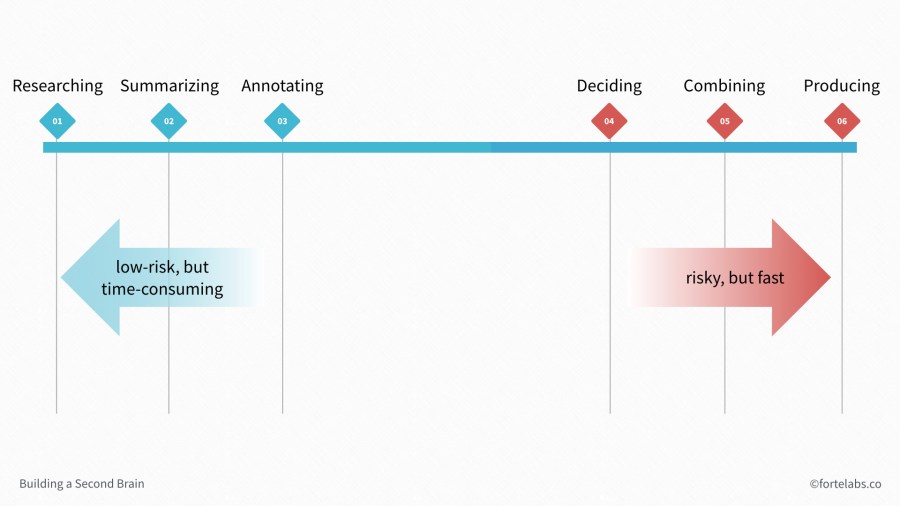
In Part 12, I described the shift from a just-in-case to a just-in-time philosophy of work, using late starts as an example of the benefits it offers.
But if nearly everything can be done later, and there are major benefits to doing so, one question comes to the forefront: what in the world should I do now?
As the constraints on how we work continue to fall away, and you can potentially do any kind of work from anywhere, at any time, the spectre of choice overload looms large. Every minute, you are faced with seemingly infinite options for what to pursue. Instead of being liberating, this possibility is often overwhelming.
Thankfully, there is a good answer for what to do at any given time, which is Principle #5: “Create subcomponents as early as possible.” I define a subcomponent as “an inherently valuable piece of a potential future project.”
#5 Create subcomponents as early as possible
With late starts we push all the fast, but risky activities (deciding, combining, producing) as late as possible, which creates space for Principle #5 to bring all the low-risk, but time-consuming activities (researching, summarizing, annotating) as early as possible.
By pushing the bulk of the work later, we create room on the front end for research, exploration, and discovery, where it makes the biggest difference. Although these activities are valuable, because we’re doing this work so far in advance, there is a lot of uncertainty as to how and when it will be used. This makes it especially important that this preliminary work be packaged up as subcomponents, which can add value to any number of future projects.
Here are some examples:
- If you think you’ll be creating a lot of business proposals in the future, start by creating a proposal template you can use again and again
- If you suspect you’ll be creating a website at some point, start collecting web clippings of websites you like in a notebook
- If you know you’ll be applying for jobs in the future, start collecting work deliverables you could use in a portfolio
These are anticipatory actions that are valuable even if the project they’re intended for doesn’t pan out. A template for business proposals is inherently valuable, independently of any specific proposal. A notebook full of model websites could be useful in any kind of web design project. A portfolio is always a good thing to have, whether you’re applying for jobs or raising funding for your company.
This is called Component Thinking, which recognizes that every product is made up of smaller subcomponents. This is true of physical products, but it’s not very easy to take them apart and put them together in a different form. But for digital products, this is trivial. Any snippet of text can be copied and pasted anywhere else. Any image or video can be downloaded and uploaded elsewhere. Even a piece of infrastructure such as cloud storage could one day be used to share PDFs, another day to host a video, and yet another to distribute homework to a class.
Having many subcomponents at your disposal gives you numerous benefits:
- Each one gives you optionality, increasing the number of options you can consider
- Each one can be reused in different projects, allowing you to leverage past work
- Each one can remove uncertainty, making future projects less risky
With digital products, subcomponents can easily come from different sources, evolve at different speeds, and be substituted for each other. A website will often evolve through a continuous process of evolution, swapping out the domain name registrar, hosting provider, webpage builder, analytics tool, and of course, content over time. All these changes may happen with no perceptible effect on the visitors.
We can take advantage of this modularity of digital products – there’s no longer any need to wait until you have all the pieces in place:
- Launch a beta version of your app, knowing that any component of it can be added later through software updates
- Send out a draft of your blog post, knowing that you can update the text at any time
- Publish an ebook on the Kindle platform, knowing that any update to the manuscript will automatically be synced wirelessly to anyone who has purchased the book
The impermanence of digital work can often feel like a curse. Nothing ever seems to be finished. We rarely get to celebrate a clear-cut completion. But we can turn this fact to our advantage – if nothing is ever final, there’s no point in waiting to get started.
When building a bridge, perhaps 10% of the work is in design, with the rest being construction. With knowledge work, it is the opposite. The actual production of knowledge work deliverables is so fast and cheap it might as well be free, whereas the difficult intellectual labor of design constitutes 90% or more of the work.
Most people solve problems through analysis, which means “separating” the problem into smaller parts. The way designers solve problems is through synthesis – by making things and putting them together. There is nothing like a tangible artifact placed in front of a real human being to bring reality forcefully into a project.
The best subcomponents are those that:
- Answer questions or test assumptions
- Need to be done anyway
- Simplify or speed up future projects
- Make future decisions faster or easier
People are often afraid to start on ambitious projects until they know they will succeed. The risk and uncertainty is so intimidating, they never take the actions that would allow them to reduce that uncertainty.
By postponing heavy production work, we create time and space for thinking about and bundling together subcomponents. These subcomponents stand on their own, while also preparing the ground for quick execution once we pull the trigger on project execution.
For each subcomponent, we can find out if there are existing products or services we can use, further reducing uncertainty. And if we have to build a subcomponent from scratch, we at least can put boundaries around the uncertainty in the form of a small project.
Follow us for updates on Twitter, Facebook, Instagram, LinkedIn, or YouTube.
The Only Subscription
You Need to
Stay at the
Edge of AI
The essential toolkit for those shaping the future
"This might be the best value you
can get from an AI subscription."
- Jay S.
Join 100,000+ leaders, builders, and innovators

Email address
Already have an account? Sign in
What is included in a subscription?
Daily insights from AI pioneers + early access to powerful AI tools









Comments
Don't have an account? Sign up!